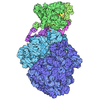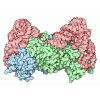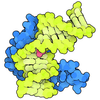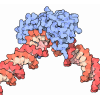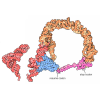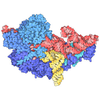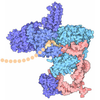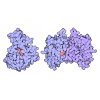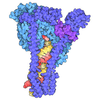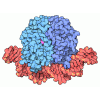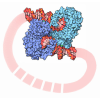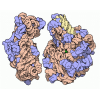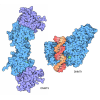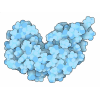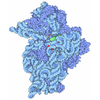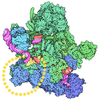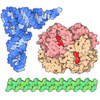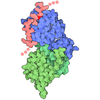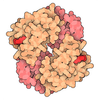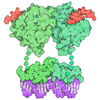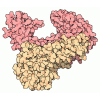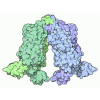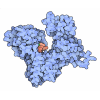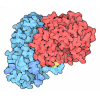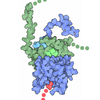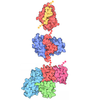+ データを開く
データを開く
- 基本情報
基本情報
| 登録情報 | データベース: PDB / ID: 9fd2 | |||||||||||||||||||||||||||
|---|---|---|---|---|---|---|---|---|---|---|---|---|---|---|---|---|---|---|---|---|---|---|---|---|---|---|---|---|
| タイトル | Structure of Pol II-TC-NER-STK19 complex | |||||||||||||||||||||||||||
 要素 要素 |
| |||||||||||||||||||||||||||
 キーワード キーワード | TRANSCRIPTION / Transcription-coupled DNA repair | |||||||||||||||||||||||||||
| 機能・相同性 |  機能・相同性情報 機能・相同性情報RNA polymerase inhibitor activity / regulation of transcription-coupled nucleotide-excision repair / negative regulation of double-strand break repair via nonhomologous end joining / nucleotide-excision repair complex / positive regulation of single strand break repair / response to auditory stimulus / regulation of transcription elongation by RNA polymerase II / B-WICH complex / DNA protection / single strand break repair ...RNA polymerase inhibitor activity / regulation of transcription-coupled nucleotide-excision repair / negative regulation of double-strand break repair via nonhomologous end joining / nucleotide-excision repair complex / positive regulation of single strand break repair / response to auditory stimulus / regulation of transcription elongation by RNA polymerase II / B-WICH complex / DNA protection / single strand break repair / positive regulation by virus of viral protein levels in host cell / Formation of RNA Pol II elongation complex / Formation of the Early Elongation Complex / Transcriptional regulation by small RNAs / RNA Polymerase II Pre-transcription Events / TP53 Regulates Transcription of DNA Repair Genes / FGFR2 alternative splicing / RNA polymerase II transcribes snRNA genes / mRNA Capping / mRNA Splicing - Minor Pathway / Processing of Capped Intron-Containing Pre-mRNA / RNA Polymerase II Promoter Escape / RNA Polymerase II Transcription Pre-Initiation And Promoter Opening / RNA Polymerase II Transcription Initiation / RNA Polymerase II Transcription Elongation / RNA Polymerase II Transcription Initiation And Promoter Clearance / RNA Pol II CTD phosphorylation and interaction with CE / Estrogen-dependent gene expression / Formation of TC-NER Pre-Incision Complex / Dual incision in TC-NER / Gap-filling DNA repair synthesis and ligation in TC-NER / mRNA Splicing - Major Pathway / response to superoxide / double-strand break repair via classical nonhomologous end joining / photoreceptor cell maintenance / chromatin-protein adaptor activity / ATP-dependent chromatin remodeler activity / spindle assembly involved in female meiosis / nuclear lumen / epigenetic programming in the zygotic pronuclei / UV-damage excision repair / positive regulation of Ras protein signal transduction / RNA polymerase binding / response to UV-B / positive regulation of DNA-templated transcription, elongation / biological process involved in interaction with symbiont / positive regulation of transcription by RNA polymerase III / regulation of mitotic cell cycle phase transition / WD40-repeat domain binding / Cul4A-RING E3 ubiquitin ligase complex / Cul4-RING E3 ubiquitin ligase complex / ATP-dependent DNA damage sensor activity / Cul4B-RING E3 ubiquitin ligase complex / ubiquitin ligase complex scaffold activity / positive regulation of transcription by RNA polymerase I / negative regulation of reproductive process / negative regulation of developmental process / RNA polymerase II complex binding / maintenance of transcriptional fidelity during transcription elongation by RNA polymerase II / cullin family protein binding / protein tyrosine kinase activator activity / viral release from host cell / RNA Polymerase I Transcription Initiation / site of DNA damage / pyrimidine dimer repair / response to X-ray / positive regulation of transcription initiation by RNA polymerase II / ATP-dependent activity, acting on DNA / ectopic germ cell programmed cell death / RNA polymerase I complex / positive regulation of viral genome replication / transcription elongation by RNA polymerase I / RNA polymerase III complex / ubiquitin-like ligase-substrate adaptor activity / response to UV / RNA polymerase II, core complex / proteasomal protein catabolic process / tRNA transcription by RNA polymerase III / positive regulation of double-strand break repair via homologous recombination / protein autoubiquitination / transcription by RNA polymerase I / JNK cascade / neurogenesis / transcription-coupled nucleotide-excision repair / positive regulation of gluconeogenesis / DNA-directed RNA polymerase complex / positive regulation of DNA repair / DNA damage checkpoint signaling / regulation of DNA-templated transcription elongation / transcription elongation factor complex / ERCC6 (CSB) and EHMT2 (G9a) positively regulate rRNA expression / response to gamma radiation / nucleotide-excision repair / transcription initiation at RNA polymerase II promoter / transcription elongation by RNA polymerase II / DNA-templated transcription initiation / Recognition of DNA damage by PCNA-containing replication complex / helicase activity / base-excision repair / regulation of circadian rhythm 類似検索 - 分子機能 | |||||||||||||||||||||||||||
| 生物種 |  Homo sapiens (ヒト) Homo sapiens (ヒト) | |||||||||||||||||||||||||||
| 手法 | 電子顕微鏡法 / 単粒子再構成法 / クライオ電子顕微鏡法 / 解像度: 3.4 Å | |||||||||||||||||||||||||||
 データ登録者 データ登録者 | Lee, S.-H. / Sixma, T.K. | |||||||||||||||||||||||||||
| 資金援助 |  オランダ, 2件 オランダ, 2件
| |||||||||||||||||||||||||||
 引用 引用 |  ジャーナル: Mol Cell / 年: 2024 ジャーナル: Mol Cell / 年: 2024タイトル: STK19 drives transcription-coupled repair by stimulating repair complex stability, RNA Pol II ubiquitylation, and TFIIH recruitment. 著者: Anisha R Ramadhin / Shun-Hsiao Lee / Di Zhou / Anita Salmazo / Camila Gonzalo-Hansen / Marjolein van Sluis / Cindy M A Blom / Roel C Janssens / Anja Raams / Dick Dekkers / Karel Bezstarosti / ...著者: Anisha R Ramadhin / Shun-Hsiao Lee / Di Zhou / Anita Salmazo / Camila Gonzalo-Hansen / Marjolein van Sluis / Cindy M A Blom / Roel C Janssens / Anja Raams / Dick Dekkers / Karel Bezstarosti / Dea Slade / Wim Vermeulen / Alex Pines / Jeroen A A Demmers / Carrie Bernecky / Titia K Sixma / Jurgen A Marteijn /   要旨: Transcription-coupled nucleotide excision repair (TC-NER) efficiently eliminates DNA damage that impedes gene transcription by RNA polymerase II (RNA Pol II). TC-NER is initiated by the recognition ...Transcription-coupled nucleotide excision repair (TC-NER) efficiently eliminates DNA damage that impedes gene transcription by RNA polymerase II (RNA Pol II). TC-NER is initiated by the recognition of lesion-stalled RNA Pol II by CSB, which recruits the CRL4 ubiquitin ligase and UVSSA. RNA Pol II ubiquitylation at RPB1-K1268 by CRL4 serves as a critical TC-NER checkpoint, governing RNA Pol II stability and initiating DNA damage excision by TFIIH recruitment. However, the precise regulatory mechanisms of CRL4 activity and TFIIH recruitment remain elusive. Here, we reveal human serine/threonine-protein kinase 19 (STK19) as a TC-NER factor, which is essential for correct DNA damage removal and subsequent transcription restart. Cryogenic electron microscopy (cryo-EM) studies demonstrate that STK19 is an integral part of the RNA Pol II-TC-NER complex, bridging CSA, UVSSA, RNA Pol II, and downstream DNA. STK19 stimulates TC-NER complex stability and CRL4 activity, resulting in efficient RNA Pol II ubiquitylation and correct UVSSA and TFIIH binding. These findings underscore the crucial role of STK19 as a core TC-NER component. | |||||||||||||||||||||||||||
| 履歴 |
|
- 構造の表示
構造の表示
| 構造ビューア | 分子:  Molmil Molmil Jmol/JSmol Jmol/JSmol |
|---|
- ダウンロードとリンク
ダウンロードとリンク
- ダウンロード
ダウンロード
| PDBx/mmCIF形式 |  9fd2.cif.gz 9fd2.cif.gz | 1.2 MB | 表示 |  PDBx/mmCIF形式 PDBx/mmCIF形式 |
|---|---|---|---|---|
| PDB形式 |  pdb9fd2.ent.gz pdb9fd2.ent.gz | 947.2 KB | 表示 |  PDB形式 PDB形式 |
| PDBx/mmJSON形式 |  9fd2.json.gz 9fd2.json.gz | ツリー表示 |  PDBx/mmJSON形式 PDBx/mmJSON形式 | |
| その他 |  その他のダウンロード その他のダウンロード |
-検証レポート
| 文書・要旨 |  9fd2_validation.pdf.gz 9fd2_validation.pdf.gz | 970.8 KB | 表示 |  wwPDB検証レポート wwPDB検証レポート |
|---|---|---|---|---|
| 文書・詳細版 |  9fd2_full_validation.pdf.gz 9fd2_full_validation.pdf.gz | 1.1 MB | 表示 | |
| XML形式データ |  9fd2_validation.xml.gz 9fd2_validation.xml.gz | 163.3 KB | 表示 | |
| CIF形式データ |  9fd2_validation.cif.gz 9fd2_validation.cif.gz | 255.6 KB | 表示 | |
| アーカイブディレクトリ |  https://data.pdbj.org/pub/pdb/validation_reports/fd/9fd2 https://data.pdbj.org/pub/pdb/validation_reports/fd/9fd2 ftp://data.pdbj.org/pub/pdb/validation_reports/fd/9fd2 ftp://data.pdbj.org/pub/pdb/validation_reports/fd/9fd2 | HTTPS FTP |
-関連構造データ
| 関連構造データ |  50325MC C: 同じ文献を引用 ( M: このデータのモデリングに利用したマップデータ |
|---|---|
| 類似構造データ | 類似検索 - 機能・相同性  F&H 検索 F&H 検索 |
- リンク
リンク
- 集合体
集合体
| 登録構造単位 | 
|
|---|---|
| 1 |
|
- 要素
要素
-DNA-directed RNA polymerase ... , 7種, 7分子 ABCEGIK
| #1: タンパク質 | 分子量: 217450.078 Da / 分子数: 1 / 由来タイプ: 天然 / 由来: (天然)  |
|---|---|
| #2: タンパク質 | 分子量: 147938.594 Da / 分子数: 1 / 由来タイプ: 天然 / 由来: (天然)  |
| #3: タンパク質 | 分子量: 31439.074 Da / 分子数: 1 / 由来タイプ: 天然 / 由来: (天然)  |
| #5: タンパク質 | 分子量: 24644.318 Da / 分子数: 1 / 由来タイプ: 天然 / 由来: (天然)  |
| #7: タンパク質 | 分子量: 19314.283 Da / 分子数: 1 / 由来タイプ: 天然 / 由来: (天然)  |
| #9: タンパク質 | 分子量: 14541.221 Da / 分子数: 1 / 由来タイプ: 天然 / 由来: (天然)  |
| #11: タンパク質 | 分子量: 13310.284 Da / 分子数: 1 / 由来タイプ: 天然 / 由来: (天然)  |
-RNA polymerase ... , 2種, 2分子 DL
| #4: タンパク質 | 分子量: 16331.255 Da / 分子数: 1 / 由来タイプ: 天然 / 由来: (天然)  |
|---|---|
| #12: タンパク質 | 分子量: 7018.244 Da / 分子数: 1 / 由来タイプ: 天然 / 由来: (天然)  |
-DNA-directed RNA polymerases I, II, and III subunit ... , 3種, 3分子 FHJ
| #6: タンパク質 | 分子量: 14477.001 Da / 分子数: 1 / 由来タイプ: 天然 / 由来: (天然)  |
|---|---|
| #8: タンパク質 | 分子量: 17162.273 Da / 分子数: 1 / 由来タイプ: 天然 / 由来: (天然)  |
| #10: タンパク質 | 分子量: 7655.123 Da / 分子数: 1 / 由来タイプ: 天然 / 由来: (天然)  |
-タンパク質 , 5種, 5分子 fbcgd
| #13: タンパク質 | 分子量: 9604.012 Da / 分子数: 1 / 由来タイプ: 組換発現 詳細: The first two residues (Gly, Ala) are residual residues after TEV protease treatment. ELOF1 sequence starts from residue 3 (Met). 由来: (組換発現)  Homo sapiens (ヒト) / 遺伝子: ELOF1 / 発現宿主: Homo sapiens (ヒト) / 遺伝子: ELOF1 / 発現宿主:  |
|---|---|
| #18: タンパク質 | 分子量: 129298.867 Da / 分子数: 1 / 由来タイプ: 組換発現 / 詳細: The construct contains a His tag at the N-terminus / 由来: (組換発現)  Homo sapiens (ヒト) / 遺伝子: DDB1, XAP1 Homo sapiens (ヒト) / 遺伝子: DDB1, XAP1発現宿主:  参照: UniProt: Q16531 |
| #19: タンパク質 | 分子量: 16997.615 Da / 分子数: 1 / 由来タイプ: 組換発現 詳細: The construct contains a twin Strep tag and a flag tag at the C-terminus 由来: (組換発現)  Homo sapiens (ヒト) / 遺伝子: DDA1, C19orf58, PCIA1 Homo sapiens (ヒト) / 遺伝子: DDA1, C19orf58, PCIA1発現宿主:  参照: UniProt: Q9BW61 |
| #20: タンパク質 | 分子量: 28717.211 Da / 分子数: 1 / 由来タイプ: 組換発現 詳細: The first three residues (Gly, Pro, Gly) are residual residues after 3C protease treatment. The coding sequence of STK19 starts from residue 4 (Met). 由来: (組換発現)  Homo sapiens (ヒト) / 遺伝子: STK19, G11, RP1 / 発現宿主: Homo sapiens (ヒト) / 遺伝子: STK19, G11, RP1 / 発現宿主:  |
| #22: タンパク質 | 分子量: 82923.164 Da / 分子数: 1 / 由来タイプ: 組換発現 / 詳細: The construct contains a His tag at the N-terminus / 由来: (組換発現)  Homo sapiens (ヒト) / 遺伝子: UVSSA, KIAA1530 Homo sapiens (ヒト) / 遺伝子: UVSSA, KIAA1530発現宿主:  参照: UniProt: Q2YD98 |
-DNA鎖 , 2種, 2分子 NT
| #14: DNA鎖 | 分子量: 18496.854 Da / 分子数: 1 / 由来タイプ: 合成 / 由来: (合成)  Homo sapiens (ヒト) Homo sapiens (ヒト) |
|---|---|
| #16: DNA鎖 | 分子量: 18298.717 Da / 分子数: 1 / 由来タイプ: 合成 / 由来: (合成)  Homo sapiens (ヒト) Homo sapiens (ヒト) |
-RNA鎖 , 1種, 1分子 M
| #15: RNA鎖 | 分子量: 8101.940 Da / 分子数: 1 / 由来タイプ: 合成 / 由来: (合成)  Homo sapiens (ヒト) Homo sapiens (ヒト) |
|---|
-DNA excision repair protein ERCC- ... , 2種, 2分子 ae
| #17: タンパク質 | 分子量: 45465.613 Da / 分子数: 1 / 由来タイプ: 組換発現 詳細: The construct contains a Strep tag II at the C-terminus 由来: (組換発現)  Homo sapiens (ヒト) / 遺伝子: ERCC8, CKN1, CSA Homo sapiens (ヒト) / 遺伝子: ERCC8, CKN1, CSA発現宿主:  参照: UniProt: Q13216 |
|---|---|
| #21: タンパク質 | 分子量: 168673.547 Da / 分子数: 1 / 由来タイプ: 組換発現 詳細: The construct contains a N-terminal HA tag and a C-terminal His tag 由来: (組換発現)  Homo sapiens (ヒト) / 遺伝子: ERCC6, CSB Homo sapiens (ヒト) / 遺伝子: ERCC6, CSB発現宿主:  参照: UniProt: Q03468, 加水分解酵素; 酸無水物に作用; 酸無水物に作用・細胞または細胞小器官の運動に関与 |
-非ポリマー , 2種, 11分子 


| #23: 化合物 | ChemComp-ZN / #24: 化合物 | ChemComp-MG / | |
|---|
-詳細
| 研究の焦点であるリガンドがあるか | Y |
|---|---|
| Has protein modification | N |
-実験情報
-実験
| 実験 | 手法: 電子顕微鏡法 |
|---|---|
| EM実験 | 試料の集合状態: PARTICLE / 3次元再構成法: 単粒子再構成法 |
- 試料調製
試料調製
| 構成要素 | 名称: Ternary complex of Pol II-TC-NER-STK19, composite map タイプ: COMPLEX / Entity ID: #1-#21 / 由来: NATURAL | ||||||||||||||||||||||||||||||
|---|---|---|---|---|---|---|---|---|---|---|---|---|---|---|---|---|---|---|---|---|---|---|---|---|---|---|---|---|---|---|---|
| 分子量 | 値: 1.17 MDa / 実験値: NO | ||||||||||||||||||||||||||||||
| 由来(天然) | 生物種:  Homo sapiens (ヒト) Homo sapiens (ヒト) | ||||||||||||||||||||||||||||||
| 由来(組換発現) | 生物種:  | ||||||||||||||||||||||||||||||
| 緩衝液 | pH: 7.5 | ||||||||||||||||||||||||||||||
| 緩衝液成分 |
| ||||||||||||||||||||||||||||||
| 試料 | 濃度: 0.15 mg/ml / 包埋: NO / シャドウイング: NO / 染色: NO / 凍結: YES 詳細: The final concentration of Pol II is around 0.15 mg/ml. The other components were added in different molar ratio. This sample was glutaraldehyde crosslinked. | ||||||||||||||||||||||||||||||
| 試料支持 | グリッドの材料: COPPER / グリッドのサイズ: 300 divisions/in. / グリッドのタイプ: Quantifoil R1.2/1.3 | ||||||||||||||||||||||||||||||
| 急速凍結 | 装置: FEI VITROBOT MARK IV / 凍結剤: ETHANE / 湿度: 100 % / 凍結前の試料温度: 277 K |
- 電子顕微鏡撮影
電子顕微鏡撮影
| 実験機器 |  モデル: Titan Krios / 画像提供: FEI Company |
|---|---|
| 顕微鏡 | モデル: FEI TITAN KRIOS 詳細: Collected on Krios 1 at Netherlands Center for Electron Nanoscopy (NeCEN) |
| 電子銃 | 電子線源:  FIELD EMISSION GUN / 加速電圧: 300 kV / 照射モード: FLOOD BEAM FIELD EMISSION GUN / 加速電圧: 300 kV / 照射モード: FLOOD BEAM |
| 電子レンズ | モード: BRIGHT FIELD / 倍率(公称値): 81000 X / 最大 デフォーカス(公称値): 2200 nm / 最小 デフォーカス(公称値): 800 nm / Cs: 2.7 mm / C2レンズ絞り径: 50 µm / アライメント法: COMA FREE |
| 試料ホルダ | 凍結剤: NITROGEN 試料ホルダーモデル: FEI TITAN KRIOS AUTOGRID HOLDER |
| 撮影 | 平均露光時間: 3.43 sec. / 電子線照射量: 50 e/Å2 フィルム・検出器のモデル: GATAN K3 BIOQUANTUM (6k x 4k) 撮影したグリッド数: 2 / 実像数: 13029 詳細: Two datasets were collected from the same sample using the same parameters. |
| 電子光学装置 | エネルギーフィルタースリット幅: 20 eV |
- 解析
解析
| EMソフトウェア |
| ||||||||||||||||||||||||
|---|---|---|---|---|---|---|---|---|---|---|---|---|---|---|---|---|---|---|---|---|---|---|---|---|---|
| CTF補正 | タイプ: PHASE FLIPPING AND AMPLITUDE CORRECTION | ||||||||||||||||||||||||
| 粒子像の選択 | 選択した粒子像数: 2866913 / 詳細: Particles were combined from two datasets. | ||||||||||||||||||||||||
| 3次元再構成 | 解像度: 3.4 Å / 解像度の算出法: OTHER / 粒子像の数: 257539 詳細: Each focused map was reconstructed using different number of particles. 対称性のタイプ: POINT | ||||||||||||||||||||||||
| 拘束条件 |
|
 ムービー
ムービー コントローラー
コントローラー








 PDBj
PDBj